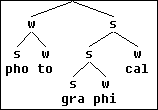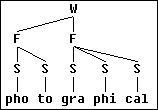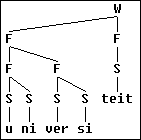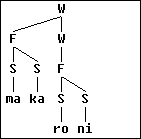Data structure
The main data structure of IPOX is the metrical tree, or, more generally, a binary-branching, headed tree.
Type definition
Tree :: Node --> Tree
| ( Tree / Tree )
| ( Tree \ Tree )
| Terminal
In this definition, the slash is used to indicate which of two sister nodes is the (prosodic) head.
Graphic representations
- conventional metrical tree: only weak-strong or strong-weak is indicated; unary nodes are ignored
- headed constituent tree: constituent labels are shown, as well as headedness
Example
two representations of the prosodic structure of the word photographical:
 metrical tree
metrical tree  headed tree
headed tree
Internal representation
W -->
(F --> (S --> "pho" \ S --> "to")
/ F --> ((S --> "gra" \ S --> "phi") \ S --> "cal"))
A node in a metrical representation is a complex feature structure (Shieber 1986).
Type definition
Node :: Category:Features
Features :: [FV*]
FV :: Node
| Feature=Value
| +Feature (Feature=true)
| -Feature (Feature=false)
Example
complex feature structure for the unstressed vowel schwa
vow:[-stressed, voc:[+back, -rnd, height=mid]]
Our data structure is not limited to the representation of prosodic headedness.
Other uses
- syntactic headedness:
VP --> (V \ NP) - morphological structure:
word --> ((prefix / root) \ suffix)
Objection
Our data structure is too general because prosodic structure is "flat", that is, non-recursive (Nespor and Vogel 1986).
Defense
- self-embedding is OK if across the board , as in (a) below
- self-embedding is compiled away in (b), obtaining (c)
- a prosodic category may not dominate a category of a higher type
Examples
 (a)
(a)  (b)
(b)  (c)
(c)
stress patterns of two Dutch words: (a) universiteit 'university'; (b=>c) makaroni 'macaroni'

